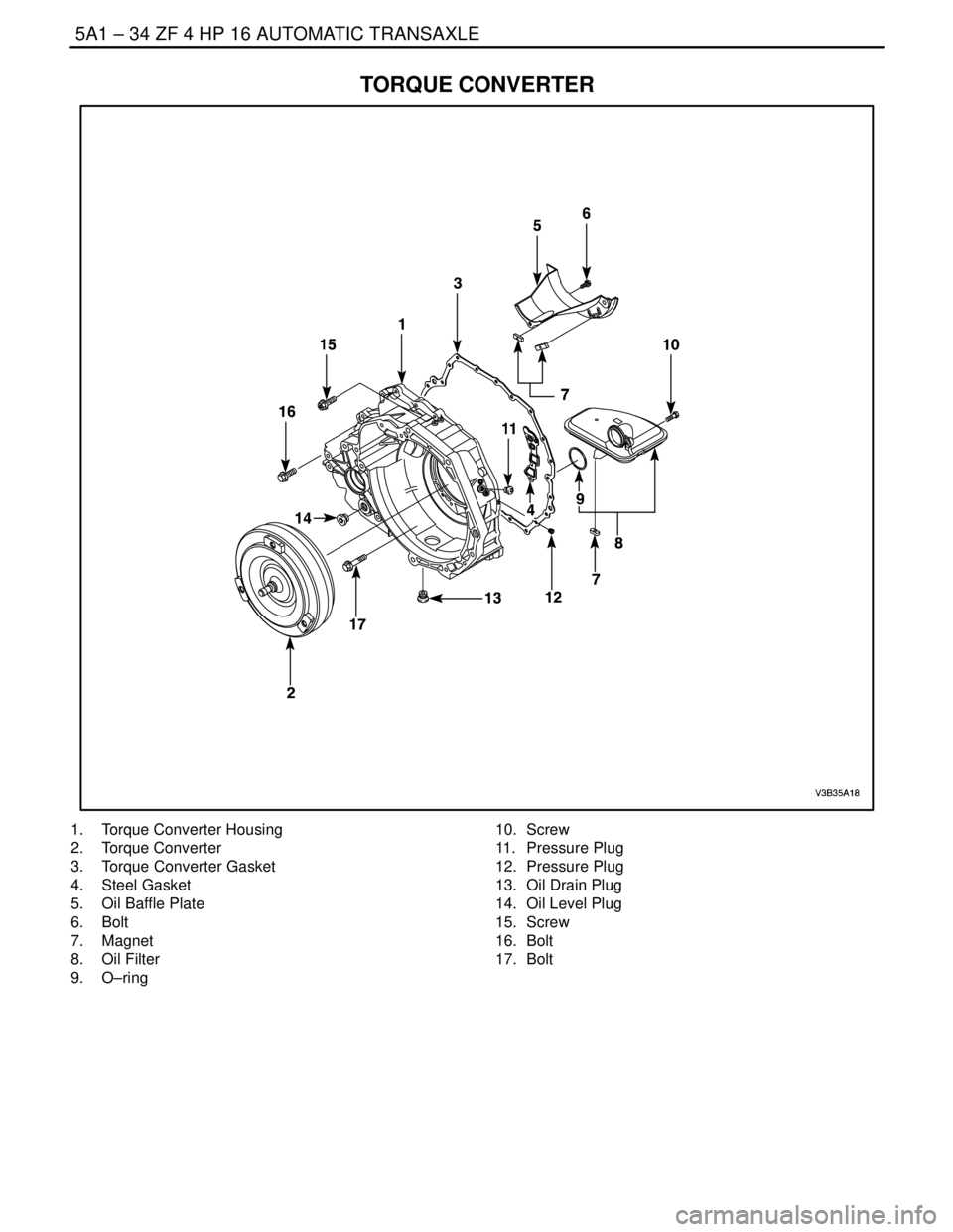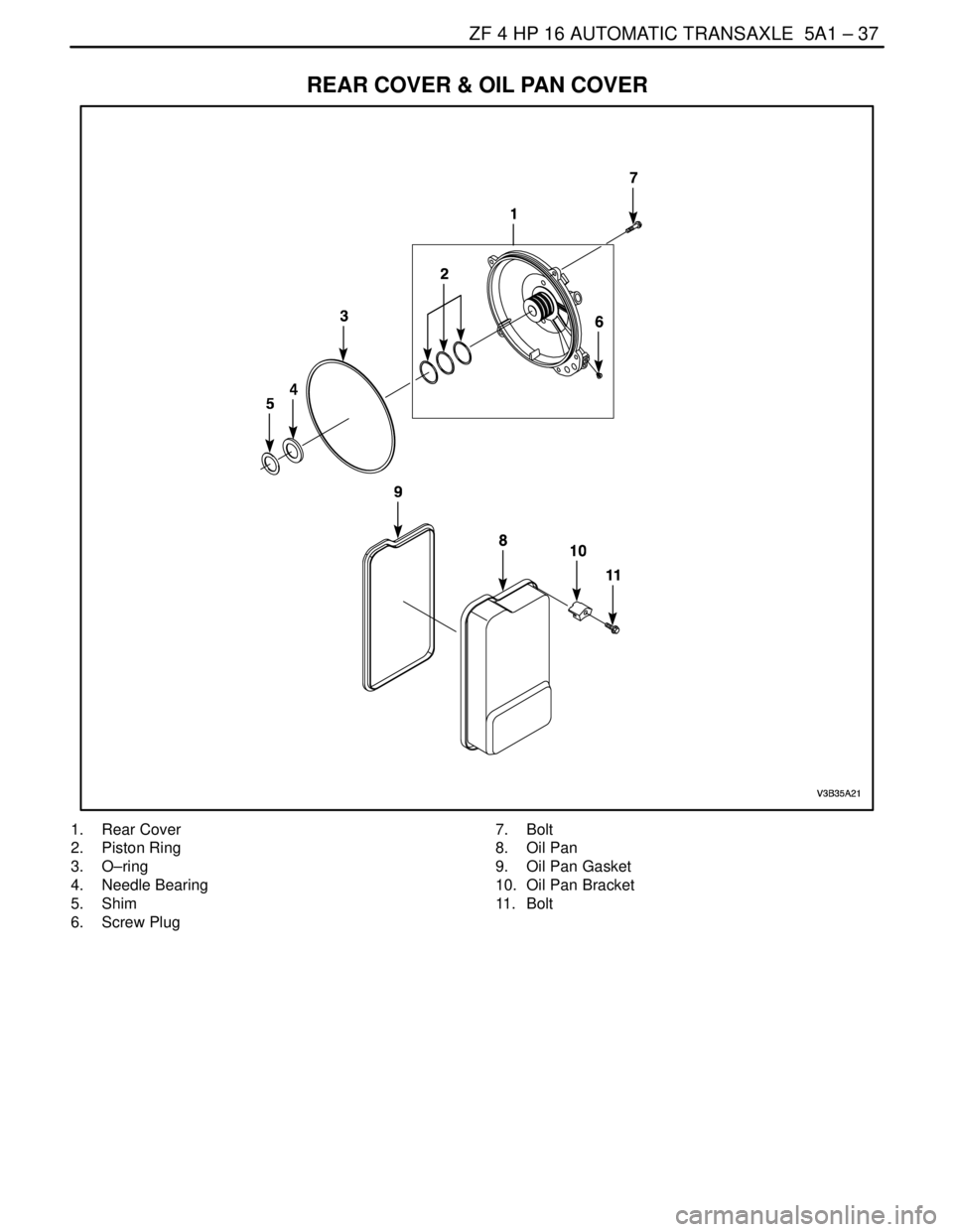2004 DAEWOO NUBIRA gas
[x] Cancel search: gasPage 1077 of 2643

4E2 – 8IREAR DRUM BRAKES
DAEWOO V–121 BL4
Installation Procedure
1. Install the wheel cylinder to the backing plate with
the wheel cylinder bolt.
Tighten
Tighten the wheel cylinder–to–backing plate bolt to 8
NSm (71 lb–in).
2. Connect the brake line to the wheel cylinder.
Tighten
Tighten the brake line to 16 NSm (12 lb–ft)
3. Install the shoe and lining, and the brake drum. Re-
fer to ”Shoe and Lining” in this section.
4. Bleed the brakes. Refer to Section 4A, Hydraulic
Brakes.
BACKING PLATE
Removal Procedure
1. Raise and suitably support the vehicle.
2. Remove the brake shoe components, including
complete removal of the parking brake with the re-
tainer. Refer to ”Shoe and Lining” in this section
and Section 4A, Hydraulic Brakes.
3. Remove the nuts that secure the wheel hub assem-
bly to the backing plate.
4. Remove the brake line and plug the opening in the
line to prevent fluid loss or contamination.
5. Remove the wheel cylinder assembly. Refer to
”Wheel Cylinder Assembly” in this section.
6. Remove the wheel hub assembly.
7. In case of ABS brake, disconnect the cable that
goes to the wheel speed sensor.
8. Separate the backing plate and the gasket.
Page 1351 of 2643

5A1 – 2IZF 4 HP 16 AUTOMATIC TRANSAXLE
DAEWOO V–121 BL4
DTC P0722 – Output Speed Sensor(OSS)
Circuit No Signal 5A1–107. . . . . . . . . . . . . . . . . . . . . .
DTC P0725 – Engine Speed Input Circuit
Malfunction 5A1–110. . . . . . . . . . . . . . . . . . . . . . . . . .
DTC P0726 – Engine Speed Input Circuit
Range/Performance 5A1–112. . . . . . . . . . . . . . . . . . .
DTC P0727 – Engine Speed Input Circuit No
Signal 5A1–114. . . . . . . . . . . . . . . . . . . . . . . . . . . . . . .
DTC P0731 – Gear 1 Incorrect Ratio 5A1–116. . . . . .
DTC P0732 – Gear 2 Incorrect Ratio 5A1–118. . . . . .
DTC P0733 – Gear 3 Incorrect Ratio 5A1–120. . . . . .
DTC P0734 – Gear 4 Incorrect Ratio 5A1–122. . . . . .
DTC P0781 – 1–2 Shift Malfunction 5A1–124. . . . . . .
DTC P0782 – 2–3 Shift Malfunction 5A1–126. . . . . . .
DTC P0783 – 3–4 Shift Malfunction 5A1–128. . . . . . .
DTC P1604 – Data Check of Internal &
Extended Ram Failed 5A1–130. . . . . . . . . . . . . . . . . .
DTC P1606 – Failure Of External Watchdog 5A1–132
DTC P1671 – CAN Transmit Message
Failure 5A1–134. . . . . . . . . . . . . . . . . . . . . . . . . . . . . . .
DTC P1672 – CAN Bus Off Failure 5A1–136. . . . . . . .
DTC P1673 – CAN Receive ECM Message
Failure 5A1–138. . . . . . . . . . . . . . . . . . . . . . . . . . . . . . .
DTC P1839 – EDS 3 Output Shorted To
Ground 5A1–140. . . . . . . . . . . . . . . . . . . . . . . . . . . . . .
DTC P1840 – EDS 3 Output Shorted To
Power 5A1–142. . . . . . . . . . . . . . . . . . . . . . . . . . . . . . .
DTC P1841 – EDS 3 Output Open 5A1–144. . . . . . . .
DTC P1850 – Solenoid 1 Output Shorted To
Ground 5A1–146. . . . . . . . . . . . . . . . . . . . . . . . . . . . . .
DTC P1851 – Solenoid 1 Output Shorted To
Power 5A1–148. . . . . . . . . . . . . . . . . . . . . . . . . . . . . . .
DTC P1852 – Solenoid 1 Output Open 5A1–150. . . .
DTC P1853 – Solenoid 2 Output Shorted To
Ground 5A1–152. . . . . . . . . . . . . . . . . . . . . . . . . . . . . .
DTC P1854 – Solenoid 2 Output Shorted To
Power 5A1–154. . . . . . . . . . . . . . . . . . . . . . . . . . . . . . .
DTC P1855 – Solenoid 2 Output Open 5A1–156. . . .
DTC P1861 – EDS 4 Output Shorted To
Ground 5A1–158. . . . . . . . . . . . . . . . . . . . . . . . . . . . . .
DTC P1862 – EDS 4 Output Shorted To
Power 5A1–160. . . . . . . . . . . . . . . . . . . . . . . . . . . . . . .
DTC P1863 – EDS 4 Output Open 5A1–162. . . . . . . .
DTC P1864 – EDS 5 Output Shorted To
Ground 5A1–164. . . . . . . . . . . . . . . . . . . . . . . . . . . . . .
DTC P1865 – EDS 5 Output Shorted To
Power 5A1–166. . . . . . . . . . . . . . . . . . . . . . . . . . . . . . .
DTC P1866 – EDS 5 Output Open 5A1–168. . . . . . . .
DTC P1867 – EDS 6 Output Shorted To
Ground 5A1–170. . . . . . . . . . . . . . . . . . . . . . . . . . . . . . DTC P1868 – EDS 6 Output Shorted To
Power 5A1–172. . . . . . . . . . . . . . . . . . . . . . . . . . . . . . .
DTC P1869 – EDS 6 Output Open 5A1–174. . . . . . . .
DTC P1871 – EDS Valve Power Supply
Circuit Shorted to Power 5A1–176. . . . . . . . . . . . . . .
DTC P1874 – Solenoid Valve Power Supply
Circuit Shorted to Power 5A1–178. . . . . . . . . . . . . . .
DTC P1881 – 2–1 Shift Malfunction 5A1–180. . . . . . .
DTC P1883 – 3–2 Shift Malfunction 5A1–182. . . . . . .
DTC P1884 – 4–3 Shift Malfunction 5A1–184. . . . . . .
DTC P1885 – 3–1 Shift Malfunction 5A1–186. . . . . . .
DTC P1886 – 4–2 Shift Malfunction 5A1–188. . . . . . .
MAINTENANCE AND REPAIR5A1–190 . . . . . . . . . . . .
ON–VEHICLE SERVICE 5A1–190. . . . . . . . . . . . . . . . . .
Transaxle Fluid Level Checking Procedure 5A1–190.
Changing the Fluid 5A1–191. . . . . . . . . . . . . . . . . . . . . .
Fluid Level Set After Service 5A1–192. . . . . . . . . . . . .
Repairing Fluid Leaks 5A1–192. . . . . . . . . . . . . . . . . . .
Case Porosity Repair 5A1–193. . . . . . . . . . . . . . . . . . . .
Shift Control Lever Assembly 5A1–193. . . . . . . . . . . . .
Shift Control Cable 5A1–195. . . . . . . . . . . . . . . . . . . . . .
Shift Control Cable Adjustment 5A1–196. . . . . . . . . . .
Transaxle Control Module(TCM) 5A1–197. . . . . . . . . .
Park/Neutral Start Switch 5A1–198. . . . . . . . . . . . . . . .
Oil Cooler Pipes/Hoses 5A1–199. . . . . . . . . . . . . . . . . .
Drive Axle Oil Seal 5A1–201. . . . . . . . . . . . . . . . . . . . . .
Oil Pan, Oil Pan Gasket 5A1–201. . . . . . . . . . . . . . . . .
Control Valve Body Assembly 5A1–203. . . . . . . . . . . .
Left Transaxle Mounting Bracket 5A1–205. . . . . . . . . .
Transaxle Assembly 5A1–206. . . . . . . . . . . . . . . . . . . . .
UNIT REPAIR 5A1–212. . . . . . . . . . . . . . . . . . . . . . . . . . .
Torque Converter 5A1–212. . . . . . . . . . . . . . . . . . . . . . .
Transaxle Holding Fixture Assembly 5A1–212. . . . . . .
Valve Body 5A1–212. . . . . . . . . . . . . . . . . . . . . . . . . . . .
Rear Cover 5A1–213. . . . . . . . . . . . . . . . . . . . . . . . . . . .
Clutch B/E 5A1–214. . . . . . . . . . . . . . . . . . . . . . . . . . . . .
Clutch B/E Measurement Procedure 5A1–217. . . . . .
Planetary Gear Set 5A1–220. . . . . . . . . . . . . . . . . . . . .
Brake C/D 5A1–221. . . . . . . . . . . . . . . . . . . . . . . . . . . . .
Differential 5A1–224. . . . . . . . . . . . . . . . . . . . . . . . . . . . .
Side Shaft 5A1–224. . . . . . . . . . . . . . . . . . . . . . . . . . . . .
Brake F, Slotted Nut 5A1–225. . . . . . . . . . . . . . . . . . . . .
Torque Converter Housing 5A1–227. . . . . . . . . . . . . . .
Shift Mechanism 5A1–228. . . . . . . . . . . . . . . . . . . . . . . .
Parking Lock System 5A1–229. . . . . . . . . . . . . . . . . . . .
Bearing Plate(With Spur Gear) Assembly 5A1–229. .
Oil Pump Assembly 5A1–229. . . . . . . . . . . . . . . . . . . . .
Differential/Side Shaft Outer Race, Bearing
Shim 5A1–230. . . . . . . . . . . . . . . . . . . . . . . . . . . . . . . .
Page 1383 of 2643

5A1 – 34IZF 4 HP 16 AUTOMATIC TRANSAXLE
DAEWOO V–121 BL4
TORQUE CONVERTER
1. Torque Converter Housing
2. Torque Converter
3. Torque Converter Gasket
4. Steel Gasket
5. Oil Baffle Plate
6. Bolt
7. Magnet
8. Oil Filter
9. O–ring10. Screw
11. Pressure Plug
12. Pressure Plug
13. Oil Drain Plug
14. Oil Level Plug
15. Screw
16. Bolt
17. Bolt
Page 1386 of 2643

ZF 4 HP 16 AUTOMATIC TRANSAXLE 5A1 – 37
DAEWOO V–121 BL4
REAR COVER & OIL PAN COVER
1. Rear Cover
2. Piston Ring
3. O–ring
4. Needle Bearing
5. Shim
6. Screw Plug7. Bolt
8. Oil Pan
9. Oil Pan Gasket
10. Oil Pan Bracket
11. Bolt
Page 1394 of 2643

ZF 4 HP 16 AUTOMATIC TRANSAXLE 5A1 – 45
DAEWOO V–121 BL4
CLUTCH PLATE DIAGNOSIS
Composition Plates
Dry the plate and inspect the plates for the following condi-
tions :
S Pitting
S Flaking
S Wear
S Glazing
S Cracking
S Charring
Chips or metal particles embedded in the lining
Replace a composition plate which shows any of these
conditions.
Steel Plates
Wipe the plates dry and check the plates for heat discolor-
ation. If the surfaces are smooth, even if colorsmear is in-
dicated, you can reuse the plate. If the plate is discolored
with hot spots or if the surface is scuffed, replace the plate.
Important : If the clutch shows evidence or extreme heat
or burning, replace the springs.
Causes of Burned Clutch Plates
The following conditions can result in a burned clutch
plate:
S Incorrect usage of clutch plates.
S Engine coolant in the transaxle fluid.
S A cracked clutch piston.
S Damaged or missing seals.
S Low line pressure.
S Valve problems.
– The valve body face is not flat
– Porosity between channels
– The valve bushing clips are improperly installed.
– The check balls are misplaced.
S The seal rings are worn or damaged
Engine Coolant in Transaxle
Notice : Antifreeze will deteriorate the O–ring seals and
the glue used to bond the clutch material to the pressure
plate. Both conditions may cause transaxle damage.
Perform the following steps if the transaxle oil cooler has
developed a leak, allowing engine coolant to enter the
transaxle:
1. Because the coolant will attach to the seal material
causing leakage, disassemble the transaxle and
replace all rubber type seals.
2. Because the facing material may become sepa-
rated from the steel center portion, replace the
composition faced clutch plate assemblies.
3. Replace all nylon parts including washers.
4. Replace the torque converter.
5. Thoroughly clean and rebuild the transaxle, using
new gaskets and oil filter.6. Flush the cooler lines after you have properly re-
paired or replaced the transaxle.
COOLER FLUSHING AND FLOW
TEST
Notice : You must flush the cooler whenever you receive
a transaxle for service. Cooler flushing is essential for
SRTA installation, major overhaul, whenever you replace
a pump or torque converter, or whenever you suspect that
the fluid has been contaminated.
After filling the transaxle with fluid, start the engine and run
for 30 seconds. This will remove any residual moisture
from the oil cooler. Disconnect the return line at the trans-
axle and observe the flow with the engine running. If the
fluid flow is insufficient, check the fluid flow by disconnect-
ing the feed line at the cooler. Observe the flow with the
engine running.
S If the flow from the cooler return line at the trans-
axle is insufficient, check the flow rate from the feed
line to the cooler. BLockage exists in the transaxle
or the cooler.
S If the flow from the transaxle feed line to the cooler
is insufficient, the transaxle is the cause of the fluid
flow problem.
S If the flow the transaxle feed line to the cooler is
insufficient, but flow from the cooler return line to
the transaxle is insufficient, inspect the cooler pipes
and fittings. Then repeat the cooler flushing proce-
dure. If the flow is still insufficient, replace the cool-
er.
TRANSAXLE FLUID LEVEL SERVICE
PROCEDURE
This procedure is to be used when checking a concern
with the fluid level in a vehicle. A low fluid level will result
in slipping and loss of drive/ reverse or delay on engage-
ment of drive/ reverse when the vehicle is cold.
The vehicle is first checked for transaxle diagnostic mes-
sages on the scan tool. If the oil level is low, it is possible
to register a vehicle speed signal fault.
The vehicle is to be test driven to determine if there is an
abnormal delay when selecting drive or reverse, or loss of
drive. One symptom of low fluid level is a momentary loss
of drive when driving the vehicle around a corner. Also
when the transaxle fluid level is low, a loss of drive may oc-
cur when the transaxle fluid temperature is low.
When adding or changing transaxle fluid use only ESSO
LT 71141 automatic transaxle fluid or other approved
fluids. The use of incorrect fluid will cause the performance
and durability of the transaxle to be severely degraded.
Fluid Level Diagnosis Procedure
1. If the vehicle is at operating temperature allow the
vehicle to cool down for two hours, but no greater
than four hours. Or if the vehicle is at cool status,
start the engine and allow the engine to idle for
approximately 5 minutes (825~875 rpm), if pos-
Page 1396 of 2643

ZF 4 HP 16 AUTOMATIC TRANSAXLE 5A1 – 47
DAEWOO V–121 BL4
Repairing the Fluid Leak
Once the leak point is found the source of the leak must
be determined. The following list describes the potential
causes for the leak:
S Fasteners are not torqued to specification.
S Fastener threads and fastener holes are dirty or
corroded.
S Gaskets, seals or sleeves are misarranged, dam-
aged or worn.
S Damaged, warped or scratched seal bore or gasket
surface.
S Loose or worn bearing causing excess seal or
sleeve wears.
S Case or component porosity.
S Fluid level is too high.
S Plugged vent or damaged vent tube.
S Water or coolant in fluid.
S Fluid drain back holes plugged.
ELECTRICAL/GARAGE SHIFT TEST
This preliminary test should be performed before a hoist
or road test to make sure electronic control inputs is con-
nected and operating. If the inputs are not checked before
operating the transaxle, a simple electrical condition could
be misdiagnosed as a major transaxle condition.
A scan tool provides valuable information and must be
used on the automatic transaxle for accurate diagnosis.
1. Move gear selector to P (Park) and set the parking
brake.
2. Connect scan tool to Data Link Connector (DLC)
terminal.
3. Start engine.
4. Turn the scan tool ON.
5. Verify that the appropriate signals are present.
These signals may include:
S ENGINE SPEED
S VEHICLE SPEED
S THROTTLE POSITION
S TRANSAXLE GEAR STATE
S GEAR SHIFT LEVER POSITION
S TRANSAXLE FLUID TEMPERATURE
S CLOSED THROTTLE POSITION LEARN
S OPEN THROTTLE POSITION LEARNT
S CLOSED ACCEL. PEDAL POSITION LEARNT
S OPEN ACCEL. PEDAL POSITION LEARNT
S A/C COMPRESSOR STATUS
S MODE SWITCH
S THROTTLE POSITION VOLTAGE
S GEAR SHIFT LEVER POSITION VOLTAGE
S TRANS. FLUID TEMPERATURE VOLTAGE
S A/C SWITCH
S MODE SWITCH VOLTAGE
S BATTERY VOLTAGE
6. Monitor the A/C COMPRESSOR STATUS signal
while pushing the A/C switch.S The A/C COMPRESSOR STATUS should come
ON when the A/C switch is pressed, and turns
OFF when the A/C switch is repushed.
7. Monitor the GEAR SHIFT LEVER POSITION signal
and move the gear shift control lever through all the
ranges.
S Verify that the GEAR SHIFT LEVER POSITION
value matches the gear range indicated on the
instrument panel or console.
S Gear selections should be immediate and not
harsh.
8. Move gear shift control lever to neutral and monitor
the THROTTLE POSITION signal while increasing
and decreasing engine speed with the accelerator
pedal.
S THROTTLE POSITION should increase with
engine speed.
ROAD TEST PROCEDURE
S Perform the road test using a scan tool.
S This test should be performed when traffic and road
conditions permit.
S Observe all traffic regulations.
The TCM calculates upshift points based primarily on two
inputs : throttle angle and vehicle speed. When the TCM
wants a shift to occur, an electrical signal is sent to the shift
solenoids which in turn moves the valves to perform the
upshift.
The shift speed charts reference throttle angle instead of
”min throttle” or ”wot” to make shift speed measurement
more uniform and accurate. A scan tool should be used to
monitor throttle angle. Some scan tools have been pro-
grammed to record shift point information. Check the
introduction manual to see if this test is available.
Upshift Procedure
With gear selector in drive(D)
1. Look at the shift speed chart contained in this sec-
tion and choose a percent throttle angle of 10 or
25%.
2. Set up the scan tool to monitor throttle angle and
vehicle speed.
3. Accelerate to the chosen throttle angle and hold the
throttle steady.
4. As the transaxle upshifts, note the shift speed and
commanded gear changes for :
S Second gear.
S Third gear.
S Fourth gear.
Important : Shift speeds may vary due to slight hydraulic
delays responding to electronic controls. A change from
the original equipment tire size affects shift speeds.
Note when TCC applies. This should occur in fourth gear.
If the apply is not noticed by an rpm drop, refer to the
”Lock–up Clutch Diagnosis” information contained in this
section.
Page 1399 of 2643

5A1 – 50IZF 4 HP 16 AUTOMATIC TRANSAXLE
DAEWOO V–121 BL4
TCC shudder should only occur during the APPLY and/or
RELEASE of the Lock up clutch.
While TCC Is Applying Or Releasing
If the shudder occurs while TCC is applying, the problem
can be within the transaxle or torque converter.
Something is not allowing the clutch to become fully en-
gaged, not allowing clutch to release, or is trying to release
and apply the clutch at the same time. This could be
caused by leaking turbine shaft seals, a restricted release
orifice, a distorted clutch or housing surface due to long
converter bolts, or defective friction material on the TCC
plate.
Shudder Occurs After TCC Has Applied :
In this case, most of the time there is nothing wrong with
the transaxle! As mentioned above, once the TCC has
been applied, it is very unlikely that will slip. Engine prob-
lems may go unnoticed under light throttle and load, but
become noticeable after TCC apply when going up a hill
or accelerating, due to the mechanical coupling between
engine and transaxle.
Important : Once TCC is applied there is no torque con-
verter assistance. Engine or driveline vibrations could be
unnoticeable before TCC engagement.
Inspect the following components to avoid misdiagnosis of
TCC shudder and possibly disassembling a transaxle and/
or replacing a torque converter unnecessarily :
S Spark plugs – Inspect for cracks, high resistance or
broken insulator.
S Plug wires – Lock in each end, if there is red dust
(ozone) or black substance (carbon) present, then
the wires are bad. Also look for a white discolor-
ation of the wire indicating arcing during hard accel-
eration.
S Distributor cap and rotor – look for broken or un–
crimped parts.
S Coil – look for black on bottom indication arcing
while engine is misfiring.
S Fuel injector – filter may be plugged.
S Vacuum leak – engine won’t get correct amount of
fuel. May run rich or lean depending on where the
leak is.S EGR valve – valve may let it too much unburnable
exhaust gas and cause engine to run lean.
S MAP sensor – like vacuum leak, engine won’t get
correct amount of fuel for proper engine operation.
S Carbon on intake valves – restricts proper flow or
air/fuel mixture into cylinders.
S Flat cam – valves don’t open enough to let proper
fuel/air mixture into cylinders.
S Oxygen sensor – may command engine too rich or
too lean for too long.
S Fuel pressure – may be too low.
S Engine mounts – vibration of mounts can be multi-
plied by TCC engagement.
S Axle joints – checks for vibration.
S TPS – TCC apply and release depends on the TPS
in many engines. If TPS is out of specification, TCC
may remain applied during initial engine starting.
S Cylinder balance – bad piston rings or poorly seal-
ing valves can cause low power in a cylinder.
S Fuel contamination – causes poor engine perfor-
mance.
TCM INITIALIZATION PROCEDURE
When one or more operations such as shown below are
performed, all learned contents which are stored in TCM
memory should be erased after the operations.
S When A/T H/W is replaced in a vehicle,
S When a used TCU is installed in other vehicle,
S When a vehicle condition is unstable (engine RPM
flare, TPS toggling and so on; at this kind of unsta-
ble conditions, mis–adaptation might be done).
1. Connect the Scan 100 with a DLC connector in a
vehicle.
2. Turn ignition switch ON.
3. Turn the power on for the Scan 100.
4. Follow the ”TCM LEARNED INITIALIZE” procedure
on the Scan 100 menu.
Notice : Before pushing ”Yes” Button for TCM initialization
on the Scan 100 screen, make sure that the condition is
as follows:
Condition :
1. Engine idle.
2. Select lever set ”P” range.
Page 1405 of 2643

5A1 – 56IZF 4 HP 16 AUTOMATIC TRANSAXLE
DAEWOO V–121 BL4
SYMPTOM DIAGNOSIS
Oil Leakage
Notice :
– Careful localization of leakage points may make it
possible to prevent incorrect or cost–intensive re-
pairs.
Test Steps :– Thoroughly clean the transaxle, engine, and sur-
rounding area(using a steam jet, for example).
– To locate leakage, use a suitable identifying spray
or similar product.
– Depending on the amount of leakage, take the
car for a short or a longer test drive – It may prove
sufficient to place the car on a hoist and run the
engine at idle speed to trace the leak.
– If possible, determine exactly which type of oil is
escaping.
Symptom
Possible CauseAction
Transaxle Oil Leak-
ageOil Pump(Torque Converter Sealing)S Visually check torque converter sealing.
S Replace the converter sealing as described in
the transaxle repair on the vehicle service.
Crankshaft Sealing RingS Check whether engine oil or TFT is leaking out.
S If leak is engine oil, replace the sealing ring as
described in the engine repair instruction.
Torque ConverterS Visual check.
S Fit an exchange converter as described in the
repair instruction.
Oil Content Too HighS Check oil level(TFT and axle oil) as described
in this chapter.
S Correct oil level, and recheck after a test drive.
Notice : Comply with the measuring procedure (fill-
ing procedure) in the repair instruction. Check the oil
level at the overflow plug adjust to proper level if nec-
essary.
O–ring at Bolt Head Damaged or Miss-
ingS Check O–ring.
S Replace O–ring as described in the repair in-
struction.
Shaft SealS Visually check the shaft seal.
S Replace the sealing ring as described in the
repair instruction.
Hose Clamp LooseS Check to ensure that the hose clamp fits tightly.
S If necessary, retighten clamp.
Oil Pan Gasket Not Installed ProperlyS Check to see if the gasket was positioned
properly.
S Install gasket properly as described in the re-
pair instruction.
Oil Pan Gasket DamagedS Check the gasket visually.
S Replace gasket as described in the repair in-
struction.
Bolt at Bracket LooseCheck the Tightening Torque
Retighten bolt
Sealing Ring at Oil DipstickS Check O–ring.
S If necessary, replace O–ring.
Sealing Ring Near End–Cover Connec-
tion DefectiveS Check sealing rings.
S Put in new sealing ring Check O–ring as de-
scribed in the repair instruction.